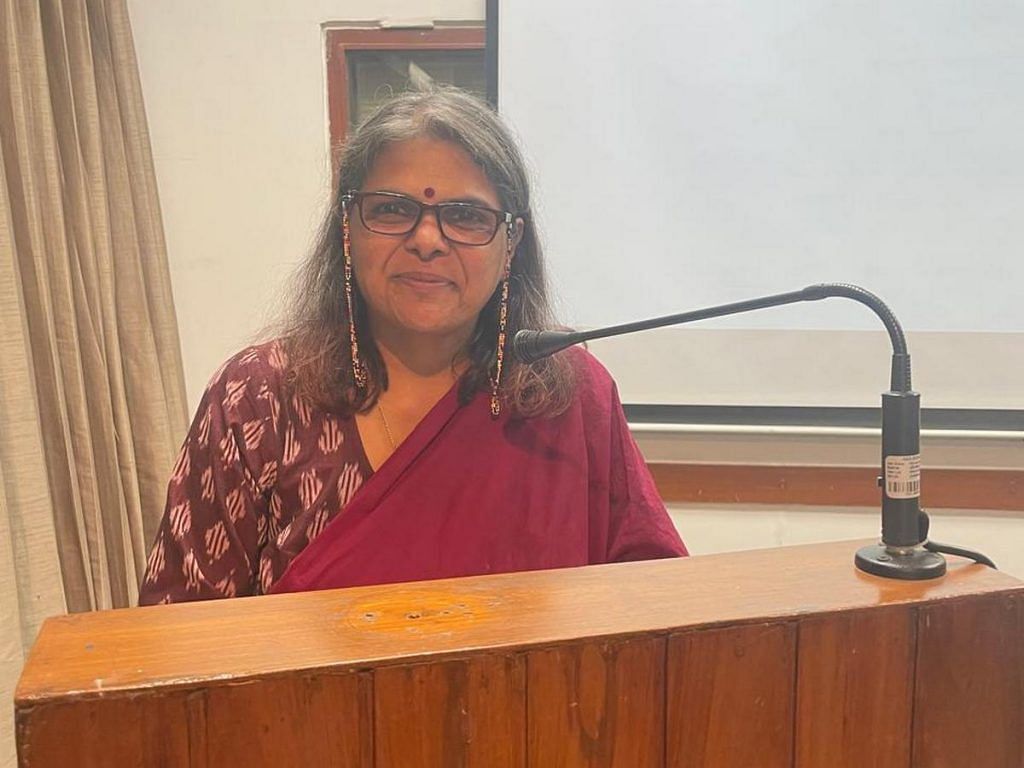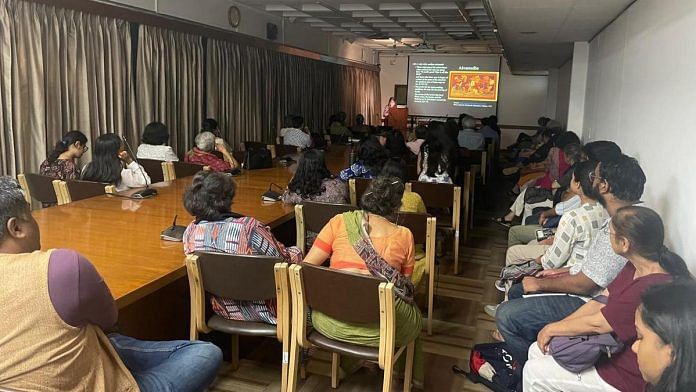New Delhi: In modern Ayurveda, a sattvic diet essentially means ‘vegetarian’, associated with purity and virtue, while tamasic food is associated with meat and unsavoury desires. But early texts weren’t so moralistic. In fact, cholera was considered sattvic simply because its fluids are clear, while a cough was labelled tamasic due to its dense, opaque mucus.
This ancient classification shows just how loosely these terms were applied back then. It’s only in later Ayurvedic texts that the gunas—sattva (goodness), rajas (energy), and tamas (darkness)—became directly tied to food.
The politics of food in India, including these shifting classifications, were the focus of a talk by author and JNU professor R Mahalakshmi at Delhi’s India International Centre on 28 August.
“Vegetables and milk were categorised as sattvic, and meat, obviously, as tamasic. This classification reflects a broader categorisation of food based on its inherent qualities,” she said.
Mahalakshmi’s talk, titled ‘Rasa, Guna, Aharya: Concepts, Practices, and Symbolism within the Food Cultures of the Indian Subcontinent,’ explored ideas and practices related to food in early India. It started with three integral concepts of food—rasa (taste or essence), guna (quality), and aharya (what’s fit for consumption)—and then expanded to include social, cultural, and moral meanings.
Rasa originally referred to the “essence” of something, like river water, while the three guna—literally ‘thread’ or ‘strand’—evolved in the Upanishads to describe the core qualities of nature. The term aharya, frequently found in Ayurvedic texts, covers what’s consumed, from food to medicinal remedies.
Mahalakshmi, who has been teaching historical studies at JNU for the last 14 years, also addressed how food taboos intersect with class and gender. She recalled Babasaheb Ambedkar’s examination of untouchability and how food-related concepts, including meat consumption, are contextualised within social frameworks.
“In such social contexts, we are not just looking at food but also at the eaters of food. So, these (classifications) indicate the way in which there are perceptions about the eaters of food,” she said.
Also Read: Indian food is our soft power abroad. Sadly, it has become too politicised these days
Religion, ritual & meat
Meat has long held a place in Hindu culture, including in religious rituals. For instance, the Kalika Purana, from Assam’s Nilachal Hills, describes a variety of animals that were sacrificed and consumed centuries ago.
“Early Indian texts, spanning several millennia, discuss various types of meat, including those from tortoises, crocodiles, and monkeys. They were considered nourishing and delightful,” Mahalakshmi said.
She pointed out that, historically, meat consumption was very much a part of Hindu culture — a fact that is often overlooked today. Even beef was not off limits, as has been addressed in numerous scholarly works, including The Myth of the Holy Cow by historian DN Jha and the writings of archaeologist HD Sankalia.
“This issue has been politically and religiously charged since the late 19th century, with the association of beef-eating with Muslims being a later development. And, the association is also inaccurate,” Mahalakshmi said.

Hindu religious practices often included ritual sacrifices of animals, she added, citing examples from Mandala 1 of the Rigveda.
“Hymns 167 and 168 detail the process where, before offering a horse to the gods, a goat is first brought and tied to a sacrificial post called upa,” she said, adding that once the horse is slaughtered, its 34 ribs are meticulously separated, and the flesh is offered as a sacrificial gift.
She noted that the flesh offered to Agni, the fire deity, was often the omentum—an organ typically discarded in meat preparation.
“This detail highlights the ritual’s symbolic nature, emphasising the importance of the sacrificial offering even in aspects that might seem mundane or practical,” she said.
Food plays a central role in sacred texts. The Bhagavad Gita, for instance, describes food’s power to sustain life and its connection to divine actions. Similarly, in the Rigveda, food is praised and discussed in both ritualistic and non-ritualistic contexts. Many Vedic rituals involve offerings such as soma (alcohol), ghee, milk, and animal sacrifices.
“The symbolism of these offerings, such as the sacrificial horse and goat, reflects the intricate relationship between food, ritual, and divine engagement,” said Mahalakshmi.
Also Read: Food fights not new to India. Medieval texts show mud-slinging among Jains, Buddhists, Hindus
A lesson from leather curry
One of the more surprising moments in the talk was when Mahalakshmi recounted the tale of Neeli, a devout Jain woman whose quick thinking saved her from a tricky situation without direct conflict.
The story goes that Neeli marries a man who presents himself as a Jain, but after moving into his home, she discovers that he and his family are actually Buddhists.
Complications arise when her father-in-law invites a monk to their home and insists that Neeli prepare a meal with meat for him.
Unwilling to violate her religious principles but unable to refuse, Neeli devises a clever plan.
“She prepares the meal by cooking the monk’s leather sandal in the gravy, ensuring it gives off a tempting aroma. The monk, oblivious to the trick, eats the meal. However, when he later searches for his sandal, he discovers that one of them is missing,” Mahakshmi said, as the audience broke into laughter.
Beneath the humour, though, was a deeper message. Mahalakshmi noted that deception, even when used to defend one’s principles, can still cause harm. She also reflected on the fact that the anger and violence seen today around food choices, particularly toward meat-eaters, is a relatively modern development and has no roots in ancient practices.
And while it’s understandable to be upset by certain food choices, violence is never justified, regardless of the circumstances.
“Whether someone is stealing out of hunger or eating a particular type of meat, killing them is unacceptable. From a modern perspective, we must reject such extreme actions and uphold humane principles,” she said. “We must stand against any form of lynching, irrespective of historical or textual precedents regarding meat consumption.”
(Edited by Asavari Singh)







Sadly most people are brain washed by propaganda and dont read religious history. Caste divisions and food are tied closely.